
The Tersk or Tersky is a Russian breed of light riding horse of Arab type. It was bred at the Tersk Stud in Stavropol Krai in the North Caucasus between about 1925 and 1940.

The Ukrainian Riding Horse or Ukrainian Saddle Horse is a modern Ukrainian breed of warmblood sport horse. Breeding began in the years after the Second World War at the stud farm of Dnipropetrovsk in central Ukraine – at that time in the USSR – and later expanded to three other state stud farms. It derives from cross-breeding of Hanoverian, Thoroughbred and Trakehner stallions with local mares or with Hungarian Furioso, Gidran Arab or Nonius mares. It incorporates the last bloodlines of the extinct Orlov-Rostopchin or Russian Saddle Horse. It was bred to compete in show jumping, three-day eventing and dressage, but is also suitable as a general riding horse.
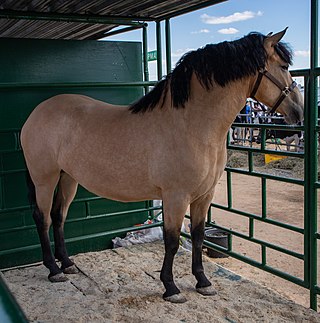
The Belarus Harness Horse, Belarusian: Беларускі запражны конь, romanized: Bielaruski zapražny koń, is a Belarusian breed of draught horse. It was bred for use in agriculture, and is also used to produce mare's milk and horsemeat.

The Lundy Pony is a British breed of pony bred on Lundy Island in the twentieth century.

The Soviet Heavy Draft is a Russian breed of heavy draft horse. It derives from the Belgian Brabant heavy draft breed. It was developed in the former Soviet Union for agricultural draft work, and was recognized as a breed in 1952. It is one of several heavy draft breeds developed in the Soviet Union in the twentieth century, others being the Russian Heavy Draft – which derived mainly from the Ardennais – and the Vladimir Heavy Draft, which was derived principally from the Clydesdale.

The Latvian Horse is a purpose-bred warmblood horse breed from Latvia. Breeding began in Latvia in the early twentieth century, and a herd book was established in 1927. The breed was officially recognised in 1952. There are two types, sometimes called the Latvian Harness Horse and the Latvian Riding Horse. The harness type was predominant until about 1960, when demand for sport horses increased and more of the saddle type were bred.

The Rhenish German Coldblood, German: Rheinisch Deutsches Kaltblut, is a breed of heavy draught horse from the Rhineland area of western Germany. It was bred in second part of the nineteenth century, principally at the Prussian state stud at Schloss Wickrath in Wickrathberg, now part of Mönchengladbach in North Rhine-Westphalia.
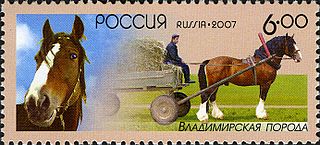
The Vladimir Heavy Draft is a Russian breed of heavy draught horse. It was bred in the early twentieth century in farms and collectives in Ivanovo Oblast and Vladimir Oblast, to the east of Moscow. The most important influence on the development of the breed was from three Clydesdale stallions foaled between 1910 and 1923. The Vladimir was officially recognised in 1946.

The Gelderlander is a Dutch breed of warmblood horse. It was bred in the province of Gelderland in the Netherlands as a carriage horse capable also of farm work. It declined in popularity in the mid-twentieth century. In 1965 it was one of the foundation breeds of the Dutch Warmblood or KWPN, the other being the heavier Groninger horse from the north. It is registered in a division of the Royal Dutch Warmblood Horse Studbook, which also has divisions for the Dutch Warmblood and for the Dutch Harness Horse.
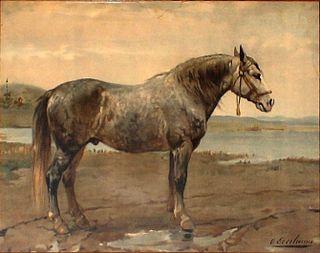
The Russian Draft or Russian Heavy Draft is a Russian breed of draft horse. It was bred in Imperial Russia in the second half of the nineteenth century, and until after the Russian Revolution was known as the Russian Ardennes. It is one of a number of draft breeds developed there at approximately the same time, others being the Lithuanian Heavy Draft, the Soviet Heavy Draft and the Vladimir Heavy Draft; it is both the oldest and the smallest of them. The present name dates from the Soviet era, and was used from 1952.
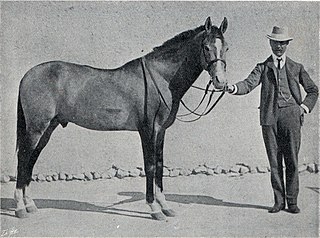
The Iomud is a breed of light horse from Turkmenistan. Like other breeds of Turkmen horse, it is named for the Turkmen tribe that raised it, the Iomud. Both the name of the horse and the name of the Turkmen clan may be spelt in many ways, including Iomud, Yomud, Yamud and Yomut. The Iomud horse is raised in Turkmenistan, particularly in the velayat of Daşoguz; in Uzbekistan; in Karakalpakstan, particularly in the Khwarezm region; and in Iraq, Iran and Turkey. Unlike the Akhal-Teke, it usually kept in herds in desert or semi-desert areas.
The Estonian Draft or Eston-Arden is a breed of draft horse developed in Estonia. They were developed from a cross of Estonian Native horses and Swedish Ardennes and officially recognized by the Estonian government in 1953. Population numbers have decreased since the early 1990s and today inbreeding is of significant concern and the breed is considered to be endangered by the Estonian government. Although originally used for heavy draft work, they are now used mainly for small-scale gardening.

The Yakutian or Yakut is a native horse breed from the Siberian Sakha Republic region. It is large compared to the otherwise similar Mongolian horse and Przewalski's horse. It is noted for its adaptation to the extreme cold climate of Yakutia, including the ability to locate and graze on vegetation that is under deep snow cover, and to survive without shelter in temperatures that reach −70 °C (−94 °F).
The Vlaamperd is a South African breed of light draught or harness horse; it is also suitable for riding. It was bred in the Western Cape region of South Africa in the early twentieth century, and resulted from cross-breeding of local mares with imported European stallions, particularly Friesians. The horses are usually black, though mares may be dark seal brown. A stud-book was started in 1983.
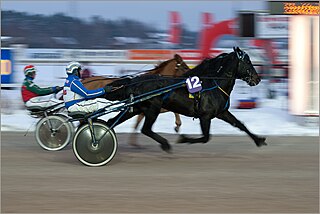
The Scandinavian Coldblood Trotter consists of two closely related and interconnected breeds of trotting horse: the Norsk Kaldblodstraver or Norwegian Coldblood Trotter and the Svensk Kallblodstravare, the Swedish Coldblood Trotter or North Swedish Trotter. Coldblood trotters are the result of cross-breeding native coldblooded farm horses – in Norway the Dølehest, in Sweden the North Swedish Horse – with lighter and faster horses. Although the Norwegian and Swedish coldblood trotters are substantially considered a single breed, two national stud-books are maintained, and registration requirements differ in some respects between the two countries.
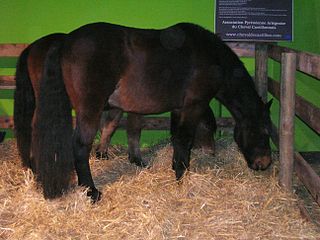
The Castillonais or Cheval Ariègeois de Castillon , also formerly called Cheval du Biros or Saint-Gironnais, is an ancient breed of small rustic saddle-horse from the Ariège département of south-western France. It may be dark bay or seal brown. It stands 135–155 centimetres at the withers, with an average height of about 145 cm. It is used principally for trekking and for driving.

The Kiso or Kiso Horse is one of the eight indigenous horse breeds of Japan. It is the only native horse breed from Honshu, the principal island of Japan. Like most other Japanese native breeds, it is critically endangered.
The Shan Horse or Shan Myinn is a breed of small mountain horse or pony from the Shan Highland, in Shan State in eastern Myanmar (Burma). It was traditionally bred by the Shan people of that area. It is one of two horse breeds in Myanmar, the other being the Burmese Horse. It is similar to the Indian Manipuri, Spiti and Bhutia breeds of small horse or pony.

The Kyrgyz Horse or Kirgiz Horse is a traditional breed of small horse from the Kyrgyz Republic (Kyrgyzstan). Kyrgyz people associate it with their nomadic past. During the Soviet era of Kyrgyz history, the Kyrgyz Horse was cross-bred with imported foreign breeds, including Don and Thoroughbred strains, to create a new and larger breed, the Novokirgiz or New Kirgiz.
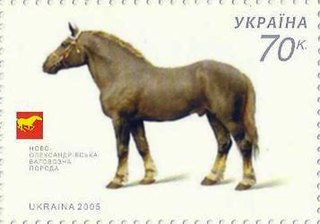
The Novoolexandrian Draught is a Ukrainian breed of draught horse. It is named for the state stud farm of Novo-Oleksandrivka in Bilovodsk Raion of Luhansk Oblast in the easternmost part of Ukraine, where it was bred. It shares its early history with the Russian Heavy Draught bred in Imperial Russia in the second half of the nineteenth century, and until after the Russian Revolution known as the Russian Ardennes; later development took place in Ukraine, where it received official recognition in 1999. It was bred for draught work, but it is also reared for meat and particularly for mare's milk, of which it is a high-yielding producer.

















